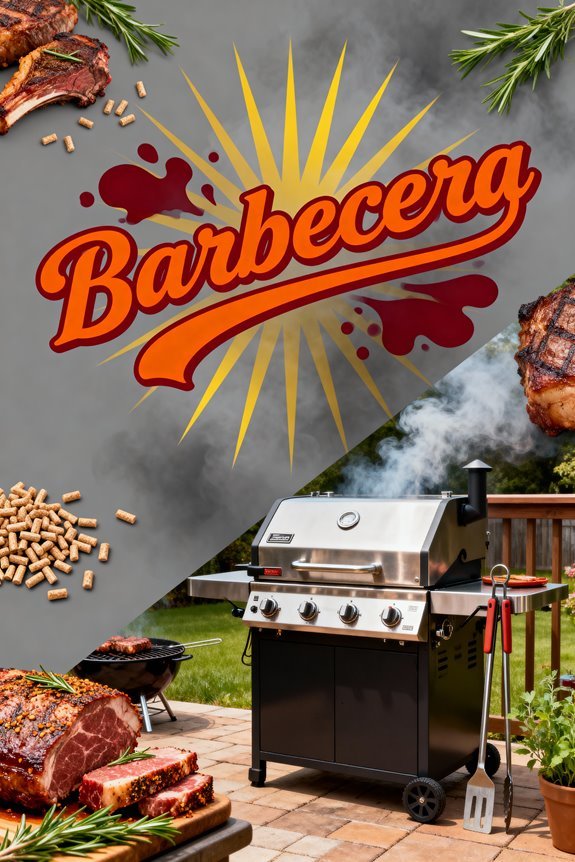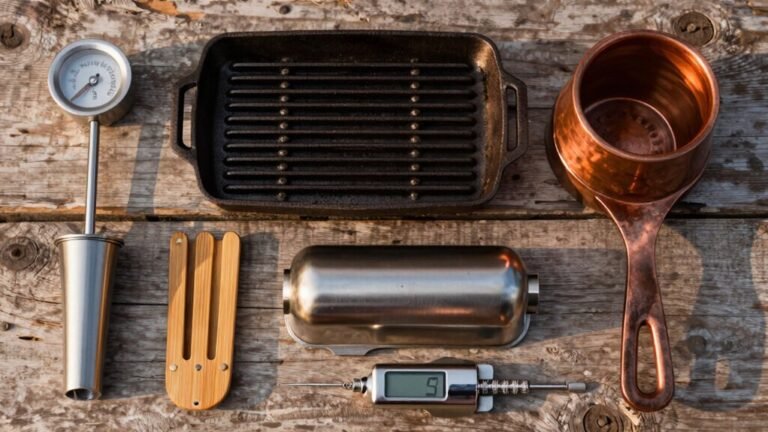Your pellet grill combines an electric auger system with digital temperature control to automate the smoking process. You’ll load hardwood pellets into the hopper, where they’re automatically fed into a firepot by the auger. A hot rod ignites them while a fan circulates combustion air, creating consistent heat and smoke. The digital controller monitors chamber temperature through probes, adjusting pellet delivery and airflow to maintain your desired cooking temperature. This closed-loop system lets you smoke, roast, or sear with precision, and understanding each component’s role will help you master this versatile cooking method.
The Fuel Source: Wood Pellets and the Hopper System
Every pellet grill depends on compressed hardwood pellets as its exclusive fuel source, engineered through a precise manufacturing process that transforms raw hardwood into efficient cooking fuel. Manufacturers dry and grind hardwood into sawdust, then compact it under extreme heat, allowing natural lignin to bind the pellets without additives. These pellets produce intense wood-smoked flavor while burning efficiently with less than 1% ash—a 40 lb bag yields only about ½ cup, simplifying ash cleanup considerably. For smoking turkey breast, pellets maintain a steady 275 degree temperature that ensures consistent results. Before first use, you should season the grates with high-smoke oil to create a protective coating.
Your grill’s hopper serves as the pellet reservoir, with capacities ranging from 10 to 35 pounds depending on your model. Proper pellet storage in cool, dry conditions prevents moisture absorption that impairs performance. An electrically powered auger feeds pellets from the hopper to the firebox in controlled amounts, maintaining precise temperature regulation throughout your cook. Modern pellet grills feature a hopper viewing window that allows you to monitor pellet levels without opening the lid.
[affiai keyword=”premium hardwood bbq smoking pellets” template=”carousel” count=”3″
The Auger System and Combustion Chamber
Once pellets drop from your hopper, an electrically powered auger takes over—a motor-driven screw mechanism that transports fuel through a sealed tube directly into the firepot below your cooking grates. The auger function is regulated by your grill’s controller, which adjusts pellet delivery rates in real-time based on temperature probe data. This guarantees precise fuel feed for consistent heat output. Similar to how thick steel construction in offset smokers helps maintain steady temperatures, the sealed design of pellet grills promotes efficient heat retention.
Inside the firepot, a hot rod ignites the pellets while a fan forces combustion air through the chamber. This controlled airflow drives combustion efficiency, burning pellets with less than 1% ash residual while generating heat and smoke. Your controller manages both auger speed and fan intensity simultaneously—speeding up when temperatures drop, slowing when targets are reached—creating a closed-loop system that maintains stable cooking temperatures automatically. The heating element ignites the pellets in the burn pot to initiate the combustion process. Unlike traditional grilling that requires 30-minute monitoring, pellet grills provide consistent, automated temperature control throughout the cooking process.
Digital Temperature Control Technology
At the heart of your pellet grill sits a sophisticated digital controller that transforms traditional outdoor cooking into precision temperature management. The system employs a PID (Proportional-Integral-Derivative) autotuning algorithm that continuously monitors your grill’s RTD sensor every 4 seconds, automatically adjusting auger feed rate and fan speed to maintain temperature precision within ±5-10°F. This eliminates manual calibration by adapting to your specific grill and environmental conditions. Starting on smoke mode setting helps achieve optimal ignition before ramping up to your target temperature. These advanced controls help prevent flare-up risks commonly associated with traditional open-flame grilling methods.
The user interface typically features dual LED displays showing both chamber and probe temperatures, with adjustments possible in 1-degree increments across a 180°F to 500°F range. Modern controllers integrate WiFIRE® or Bluetooth connectivity, enabling remote monitoring through smartphone apps. You’ll receive real-time alerts, software updates, and diagnostic feedback—all supporting consistent results whether you’re smoking, grilling, or roasting. Advanced controllers may also include a manual pellet feed option for greater user flexibility during startup or specific cooking scenarios.
Heat Circulation and Smoke Distribution
When you close the lid on your pellet grill, you’re initiating a precision-engineered convection system that transforms raw combustion into evenly distributed heat and smoke. The internal fan continuously forces fresh air into the firepot while simultaneously propelling heated air and smoke throughout the cooking chamber. Heat diffusers positioned above the firepot spread thermal energy across the entire cooking surface, preventing hot spots and shielding food from direct flame contact. Similar to two-zone grilling, this indirect heating method ensures even cooking and optimal smoke absorption. Like traditional charcoal grills, radiant heat transfer plays a crucial role in creating perfect sear marks and crusts on your food.
Heat distribution relies on forced convection combined with radiant heat from the diffuser plates. Smoke intensity varies inversely with temperature—lower settings (225–275°F) produce pronounced smoldering and robust wood flavor, while higher temperatures yield cleaner combustion and milder smoke character. The drip tray intercepts grease, maintaining consistent airflow and preventing flare-ups that would compromise both temperature stability and smoke quality. The digital controller regulates pellet feed rate to maintain your selected cooking temperature throughout the entire cook.
[affiai keyword=”pellet grill heat diffuser plates” template=”carousel” count=”3″
Cooking Capabilities and Performance Features
This engineered circulation system enables a pellet grill’s remarkable versatility—transforming it from a low-temperature smoker into a high-heat searing station with simple controller adjustments. You’ll span temperatures from 180°F for brisket to 700°F for searing steaks, executing multiple cooking techniques in one unit. Digital controllers regulate pellet feed rates and airflow, maintaining precise heat levels through integrated sensors. You can monitor internal food temperatures via built-in meat probes that communicate directly with the controller.
Different hardwood pellets create distinct flavor profiles—hickory for robust smoke, apple for milder sweetness. The auger’s consistent pellet delivery produces clean, thin blue smoke rather than bitter, heavy clouds. For perfect prime rib, the grill maintains low and slow temperatures between 225°F and 250°F. Cooking capacity ranges from 300 to over 1000 square inches, accommodating everything from weeknight dinners to whole turkeys, while larger hoppers support extended smoking sessions without refilling. Modern pellet grills also feature WiFi and Bluetooth connectivity that allows you to control temperatures and monitor cooking progress remotely from your smartphone. Smoked meats like sausage can maintain peak freshness for up to 3 weeks when stored properly in the refrigerator.







